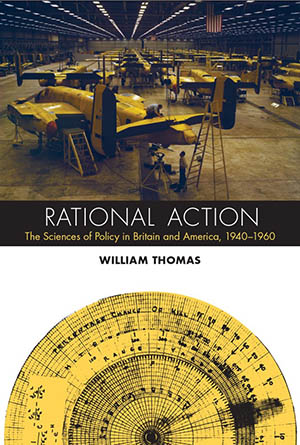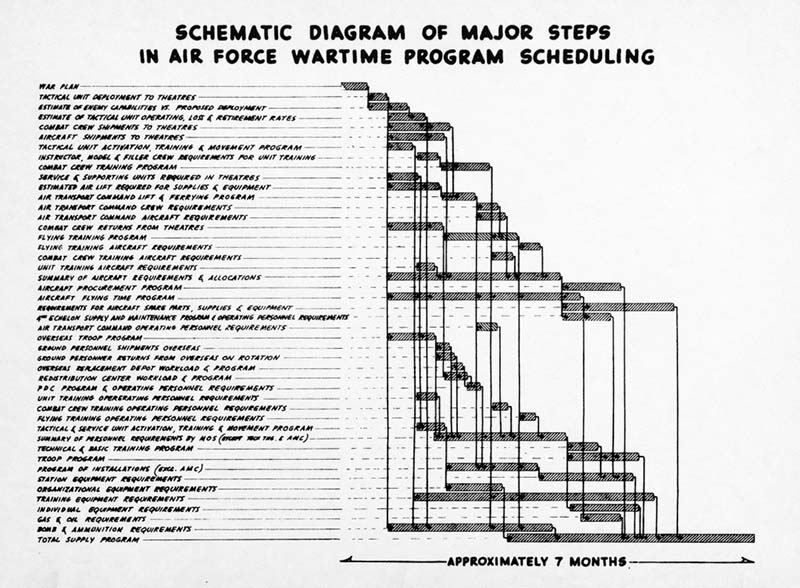Among the most important and common questions that historians of science and STS scholars address is how technical cultures interact with various “lay” communities, such as policymakers, executive decision makers, juries, and public stakeholders. Within STS broadly, scholars have usually thought about these relations within an analytical framework of boundary negotiations. In this framework, technical experts do political work to stake out an epistemic terrain in which their claims will carry an unchallengeable authority. The idea of “science” is important in this framework, because it supposedly signifies (to historical and contemporary actors) knowledge that is uniquely authoritative and stands outside the influence of society and culture.
My research on the history of “operational” or “operations research” (OR) has led me to question how well this model describes actual cultures of expertise. One of the prototypical sciences of decision making, OR originated in World War II in scientists’ scrutiny of military tactics and procedures. In the postwar period, a civilianized version of OR, directed at industrial problems, arose, accompanied by a body of formalized (i.e., mathematized) OR theory. Prior scholars have supposed that formalization constituted a move to consolidate OR’s scientific authority. I believe that to understand the development, we require an entirely different understanding not only of OR’s history but of how cultures of expertise operate.
The prevailing STS model of formalism and expertise
To date, historians have generally lumped OR with earlier managerial sciences such as Taylorism, as well as with the contemporaneous spread of formalized theories of behavior in the 1950s and after. These later theories have described all kinds of human (and even some non-human) behavior, but, like OR, they have been applied predominantly to economic behaviors of exchange and management.
Historians have supposed that the abstractness of formalism allowed theoreticians to assert the objective, extra-cultural status of their work. Such claims, the historians argue, found influence in a postwar culture that was enthusiastic about and deferential toward science as an institution. However, they suppose that, following in the tradition of Taylorism, such work actually described, and thus normalized, behaviors amenable to the same culture of capitalist liberalism that offered the theoreticians their patronage.
For example, in his preface to the 2012 volume Cold War Social Science, Ted Porter, a historian of the social sciences, asserts that for social scientists of the era it was “almost axiomatic that the more abstract, theoretically or quantitatively rigorous form of science is inherently the more powerful.” Social scientists’ “preoccupation with neutral objectivity” constituted an “ideological obfuscation” that made it plausible to claim their ideas stood “outside the value-laden character of the processes and interests that shaped the production and uses of social knowledge.” This allowed social scientists of the era both to transform their fields, and serve as influential advisers.

This view is widely held and it should be taken seriously. Ultimately, though, my research has not supported its conclusions. I detail an alternative analysis in my book, Rational Action: The Sciences of Policy in Britain and America, 1940–1960, which came out last year. In brief, my argument is that formalization carried little innate authority for either scientific theorists or lay managers and policymakers, and that, to understand the development of OR and related fields, we must understand the collaborative social and intellectual relations between different kinds of scientific analysis and theory, as well as between scientific and decision-making cultures.
Wartime Operations Research

Cover of “Combat Performance of the Remote Control Turrets of B-29 Aircraft,” XX Bomber Command, Operations Analysis Section, Report No. 14, February 10, 1945. Papers of Curtis E. LeMay, Box 37. Library of Congress, Manuscript Collections, Washington, DC.
During World War II, scientists engaged in OR (a.k.a. “operations analysis”) often described their work as the application of “scientific method” to problems of warfare. However, we should not take this to mean that they thought “science” represented an authoritative form of expertise. The eminent British physicist Patrick Blackett, generally recognized as the wartime “dean” of OR, reflected on this point in a 1953 lecture:
Operational research is not, as some people think, a case of the bright scientist suddenly intervening and telling the experts what to do. It is very much more the slow and careful enquiry into extremely complicated matters by scientists who have soaked themselves in the atmosphere of an operational command.
Notice here who receives the title of “expert”—the traditional military authorities. Wartime OR did not displace their culture: it was explicitly built on top of it. OR clarified the rationales that informed military officers’ decision making, probed those rationales’ logic, and gathered data to see what courses of action made the most sense in light of it. None of this was especially foreign to existing military experience. Even if military personnel didn’t follow every point OR scientists made, they could generally assess for themselves whether OR work improved their deliberations, and decide whether to take OR scientists’ advice.
The postwar turn to theory
The successes of wartime OR resulted in the postwar establishment of a new civilian OR profession geared toward industrial management, accompanied by the growth of academic programs in OR. It was in this postwar incarnation that OR began to redefine itself around a body of formal theory, which included game theory, linear programming, inventory theory, queuing theory, and related mathematical, statistical, and computational domains.

In the World War II U.S. Army Air Forces, a “program” connoted the steps needed to undertake military operations. The mathematical technique of “linear programming” found not only feasible but economically optimal ways to arrange these steps, and was applicable to many other computational problems as well. From “Scientific Planning of Military Programs,” Project SCOOP Report 4-PU, May 20, 1948.
In my view this turn is difficult to explain. If formalism did not make OR into a more authoritative science, as the prevailing view holds, then it seems to have turned it into a relatively constrained specialism, with a narrower range of applications. What I believe happened is that, in attempting to transplant the more prosaic wartime model of OR into civilian contexts, OR’s proponents faced steep competition from seasoned managers as well as from management consultants, cost accountants, and others who had been studying business problems for some time. OR managed to survive in this competitive environment by developing novel and useful tools. Linear programming, for example, could solve dicey logistical quandaries, like finding optimal methods of blending gasoline, or determining the most economical way to transport goods from multiple warehouses to multiple points of use. While the older, more expansive vision of OR was never rejected, it was eventually overwhelmed by this new “toolkit” view of the field.
The problem with this explanation is that OR’s proponents also developed a whole range of decision-making theories that do not conform to the toolkit model. Work in areas such as game theory was almost always too abstract to be applied. It did, though, have a definite academic appeal, because it illuminated the logical intricacies of certain kinds of decision problems, or, even more abstractly, it opened up novel mathematical structures for exploration. Such theories remain influential today in academic fields such as political science and cognitive science, and their proponents have often argued that they could yield improved conceptual understanding of decision problems, even if they were not quantitatively applicable.
Managing theory
There was an important continuity between wartime and civilian varieties of OR: both required intensive engagement between OR scientists and established decision makers to ensure the legitimacy of OR work. In the theory-heavy postwar incarnation of OR, such engagement was necessary to determine which tools could be used to advantage, or which theory-derived conceptual insights genuinely enhanced organizational decision-making. This wasn’t so much negotiating boundaries between kinds of expertise as it was blurring them, or perhaps a melding of different kinds of expertise together.
This management of theory was a difficult task, and we still don’t have a very good handle on how it worked in practice, or just how often it was successful, or to what degree it did or did not unbalance prior mechanisms of organizational deliberation and decision making. What is clear is that individuals in fields with both practical and academic components developed strategies for dealing with the problem. This is true of OR, but also of fields like economics and finance, “data science” and “analytics,” artificial intelligence, and so on. If we pay attention, we can still find people in these fields working and re-working these issues out among themselves.
I think that, moving forward, historians and others in STS could do a couple of things. First, we can collect, collate, publicize, and analyze such discussions so that the people who have to work through these issues don’t have to constantly start over from scratch. For ourselves, we can also develop more sophisticated ideas about how expertise operates in the real world. Personally, I have found Rob Evans and Harry Collins’s work very relevant, but I also think there is a lot more that sociologists and anthropologists could do to clarify the ways that expertise is organized and deployed. The one suggestion I would make here is that scholars shouldn’t be afraid to move beyond the models that have prevailed now within STS for about a quarter century.
References
Harry Collins and Robert Evans. 2007. Rethinking Expertise. Chicago: University of Chicago Press.
Paul Erickson. 2015. The World the Game Theorists Made. Chicago: University of Chicago Press.
Mark Solovey and Hamilton Cravens, eds. 2012. Cold War Social Science: Knowledge Production, Liberal Democracy, and Human Nature. New York: Palgrave Macmillan.
William Thomas. 2015. Rational Action: The Sciences of Policy in Britain and America, 1940–1960. Cambridge, Mass.: MIT Press.
